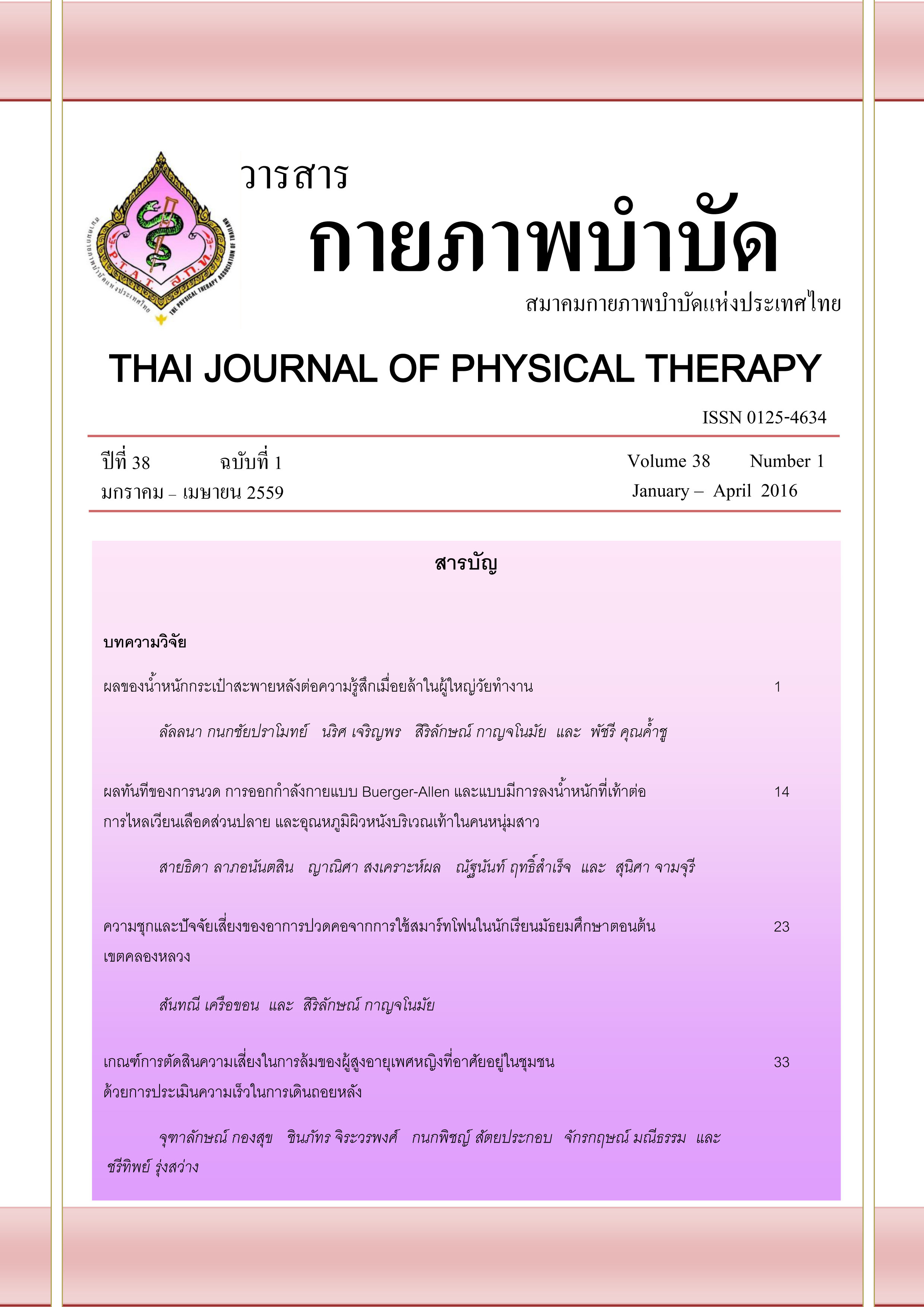ความชุกและปัจจัยเสี่ยงของอาการปวดคอจากการใช้สมาร์ทโฟนในนักเรียนมัธยมศึกษาตอนต้นเขตคลองหลวง
Main Article Content
บทคัดย่อ
สมาร์ทโฟนเป็นเทคโนโลยีหนึ่งที่ได้รับความนิยมและใช้กันอย่างแพร่หลายในกลุ่มเด็กและวัยรุ่น และการใช้สมาร์ทโฟนมีความสัมพันธ์กับอาการปวดบริเวณคอ ในการศึกษานี้จึงมีวัตถุประสงค์เพื่อหาความชุกและความสัมพันธ์ระหว่างอาการปวดบริเวณคอกับการใช้สมาร์ทโฟน ในเด็กนักเรียนมัธยมต้น 12-15 ปี
วิธีการศึกษา: รูปแบบการศึกษาภาคตัดขวางเชิงวิเคราะห์ผู้เข้าร่วมวิจัยคือนักเรียนชั้นมัธยมศึกษาตอนต้นเขตคลองหลวง อายุ 12-15 ปี เก็บข้อมูลด้วยแบบสอบถามเกี่ยวกับการใช้สมาร์ทโฟน บันทึกภาพทางด้านข้างของมุมคอและประเมินมุมการเคลื่อนไหวคอด้วยไมรินโกนิโอมิเตอร์
ผลการศึกษา: นักเรียนทั้งหมด 753 ราย มีอาการปวดคอจากการใช้สมาร์ทโฟนจำนวน 258 ราย คิดเป็นความชุก 34.26% นอกจากนี้ยังพบว่าการใช้สมาร์ทโฟนมากกว่า 165 นาทีต่อวันมีความเสี่ยงต่ออาการปวดคอ (95%CI: 1.11-24.79) และดัชนีมวลกายมากกว่า 22.90 (95%CI: 0.57-6.28) ยังมีแนวโน้มต่ออาการปวดคอจากการใช้สมาร์ทโฟนอีกด้วย
สรุปผลการศึกษา: ความชุกของอาการปวดคอจากการใช้สมาร์ทโฟนค่อนข้างสูง การใช้สมาร์ทโฟนมากกว่า 165 นาทีต่อวัน เป็นปัจจัยเสี่ยงที่สำคัญต่อการเกิดอาการปวดคอ ดังนั้นการใช้สมาร์ทโฟนบ่อยๆ อาจทำให้เสี่ยงต่ออาการปวดคอได้
Article Details
เอกสารอ้างอิง
2. Berolo S, Wells RP, Amick BC 3rd. Musculoskeletal symptoms among mobile hand-held device users and their relationship to device use: A preliminary study in a Canadian university population. Appl Ergon. 2011;42(2):371-8.
3. Kim MS. Influence of neck pain on cervical movement in the sagittal plane during smartphone use. J Phys Ther Sci. 2015;27(1):15-7.
4. Lee S, Kang H, Shin G. Head flexion angle while using a smartphone. Ergonomics. 2015;58(2):220-6.
5. Straker L, Jones KJ, Miller J. A comparison of the postures assumed when using laptop computers and desktop computers. Appl Ergon. 1997;28(4):263-8.
6. Neumann DA. Kinesiology of the musculoskeletal system: Foundations for physical rehabilitation. St. Louis: Mosby. 2002
7. Kim HJ, DH, Kim JS. The relationship between smartphone use and subjective musculoskeletal symptoms and university students. J PhysTher Sci. 2015;27(3):575-9.
8. Seghers J, Jochem A, Spaepen A. Posture, muscle activity and muscle fatigue in prolonged VDT work at different screen height settings. Ergonomics. 2003;46(7):714-30.
9. Young JG, Trudeau M, Odell D, Marinelli K, Dennerlein JT. Touch-screen tablet user configurations and case-supported tilt affect head and neck flexion angles. Work. 2012;41(1):81-91.
10. Goniometer ”Myrin”. Available from: http://www.masterpiece.dk/UploadetFiles/10897/138/Produktblad_Goniometer.pdf.
11. McLean L. The effect of postural correction on muscle activation amplitudes recorded from the cervicobrachial region. J Electromyogr Kinesiol. 2005;15(6):527-35.
12. Davis JM. Carbohydrated, branched-chain amino acids and endurance: The central fatigue hypothesis. Gatorade Sports Science Exchange. 1996;9(2).
13. Farina D, Leclerc F, Arendt-Nielsen L, Buttelli O, Madeleine P. The change in spatial distribution of upper trapezius muscle activity is correlated to contraction duration. J Electromyogr Kinesiol. 2008;18(1):16-25.
14. Edmondston S, Björnsdóttir G, Pálsson T, Solgård H, Ussing K, Allison G. Endurance and fatigue characteristics of the neck flexor and extensor muscles during isometric tests in patients with postural neck pain. Manual Therapy. 2011;16(4):332-8.
15. Enoka RM. Mechanisms of Muscle Fatigue: Central Factors and Task Dependency. J Electromyogr Kinesiol. 1995;5(3):141-9.
16. Hansraj KK. Assessment of stresses in the cervical spine caused by posture and position of the head . Surg Technol Int. 2014;25(?):277-9.
17. Allen DG, Lamb GD, Westerblad H. Skeletal Muscle Fatigue: Cellular Mechanisms. Physio Rev. 2007;88(1):287-332.


